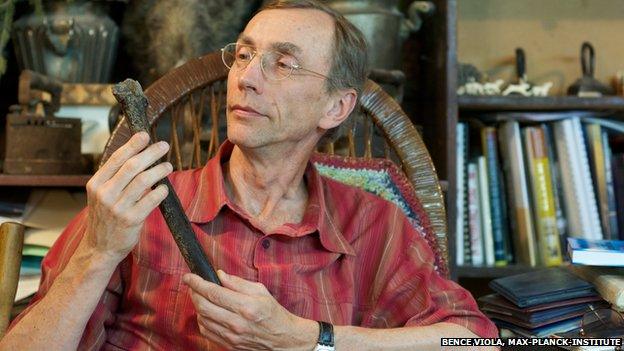DNA yields secrets of human pioneer
- Published
DNA analysis of a 45,000-year-old human has helped scientists pinpoint when our ancestors interbred with Neanderthals.

Universal human: This reconstruction is of a different modern human from Romania 43,000 years ago. But it gives some clues as to what the Siberian man might have looked like. This population was not long out of Africa and genetically midway between Europeans and Asians
The genome sequence from a thigh bone found in Siberia shows the first episode of mixing occurred between 50,000 and 60,000 years ago.
The male hunter is one of the earliest modern humans discovered in Eurasia.
The study in Nature journal, external also supports the finding that our species emerged from Africa some 60,000 years ago, before spreading around the world.
The analysis raises the possibility that the human line first emerged millions of years earlier than current estimates.
The work of Prof Svante Paabo, from the Max Planck Institute in Leipzig, Germany, is rewriting the story of humanity. Prof Paabo and his colleagues have pioneered methods to extract DNA from ancient human remains and read its genetic code.
From this sequence, the scientist has been able to decipher an increasingly detailed story of modern humans as they spread across the globe.
"The amazing thing is that we have a good genome of a 45,000-year-old person who was close to the ancestor of all present-day humans outside Africa," He told BBC News.
Prof Paabo has analysed DNA from part of a leg bone of a man that lived in Western Siberia around 45,000 years ago. This is a key moment at the cross roads of the world, when modern humans were on the cusp of an expansion into Europe and Asia.

And the thigh bone is connected to your... evolutionary past. Prof Paabo Svante has unlocked the secrets contained in this femur from one of the earliest humans discovered out of Africa,
The key finding was that the man had large, unshuffled chunks of DNA from a now extinct species of human, Neanderthals, who evolved outside of Africa.
"Our analysis shows that modern humans had already interbred with Neanderthals then, and we can determine when that first happened much more precisely than we could before."
Prof Paabo and his team published research in 2010 that showed that all non-African humans today have Neanderthal DNA, external. But that genetic material has been broken into much smaller chunks over the generations.
By extrapolating the size of DNA chunks backwards, Prof Paabo and his colleagues were able to calculate when the first interbreeding with Neanderthals occurred. His study shows that it was between 50,000 and 60,000 years ago.
According to Prof Chris Stringer of the Natural History Museum in London, this early interbreeding might indicate when the ancestors of people living outside of Africa today made their first steps out of the continent in which our species evolved more than 150,000 years ago.
Prof Stringer was among those who believed that the first exit by modern humans from Africa that give rise to people outside of Africa today might have happened earlier, possibly 100,000 years ago. The evidence from Prof Paabo's research is persuading him that it was now much later.
"There is a dispute as to when that 'Out of Africa' event happened and this fossil helps to look at that. It is close to the time I think that modern humans exited from Africa and gave rise to the populations in the rest of the world. I think that exit happened 60,000 years ago," he told BBC News.

Crossroads for humanity. The bone was found in the river Irtysh in Western Siberia at a time when the human race was beginning its expansion across the world
The new narrative seems to fit in with a recent new, more accurate dating of the arrival of modern humans into Europe by Prof Thomas Higham of Oxford University. Research published in August showed that this happened 45,000 years ago.
Watershed
Prof Paabo's 45,000-year-old man seems to have lived at a point that was both geographically, and in time, a crossroads for humanity.
"This does seem to mark a watershed where modern humans were pushing the boundaries further and further in their dispersal out of Africa," according to Prof Stringer.
Prof Paabo also compared the DNA of the man living 45,000 years ago with those living today. He found that the man was genetically midway between Europeans and Asians - indicating he lived close to the time before our species separated into different racial groups.
Prof Paabo was also able to estimate the rate at which human DNA has changed or mutated over the millennia. He found that it was slower than the rate suggested by fossil evidence and similar to what has been observed in families.
"We have caught evolution red-handed!" he said gleefully.
This raises the possibility that the very first species of the human line separated from apes 10 or 11 million years ago - rather than the five or six million years ago that genetic evidence had previously suggested.
But he stressed in his research paper that much more analysis was needed before re-dating the emergence of the human line.
"We caution that (mutation) rates may have changed over time and may differ between human populations," he said.